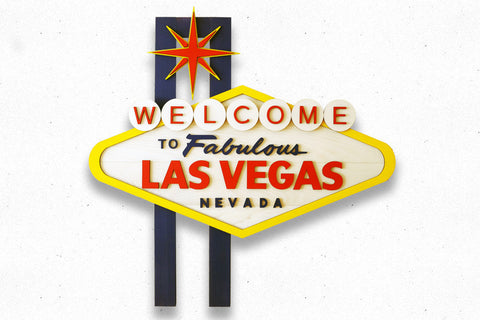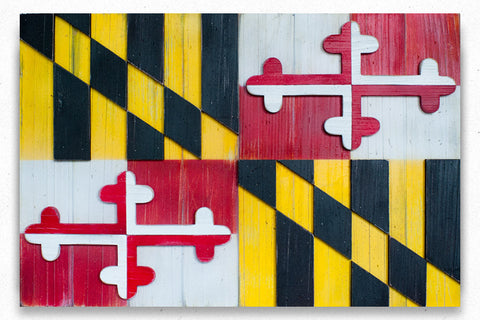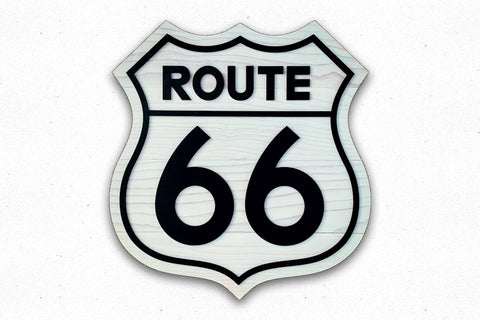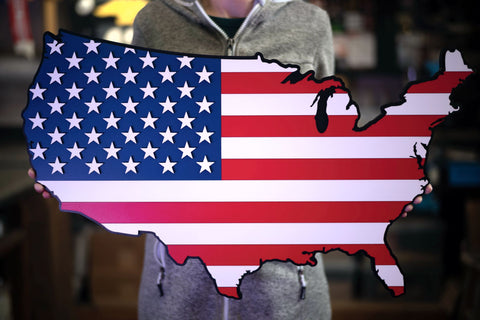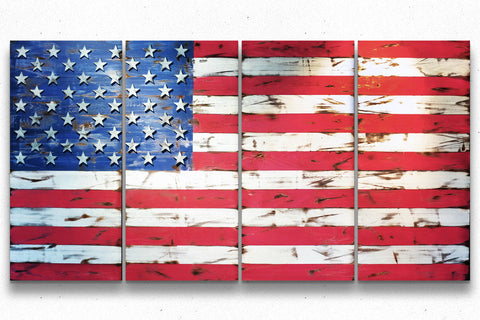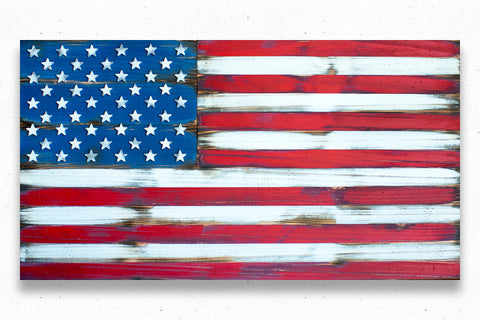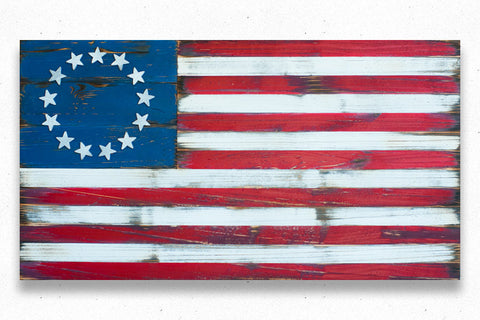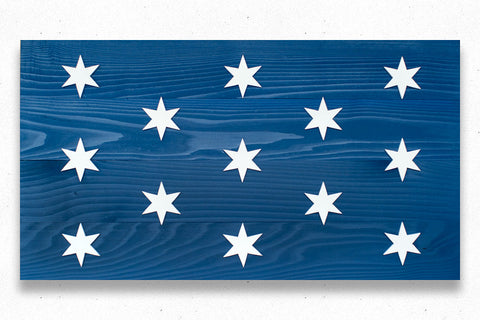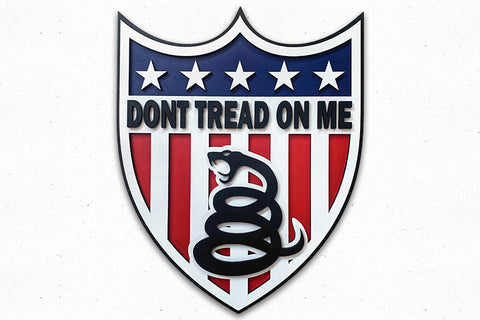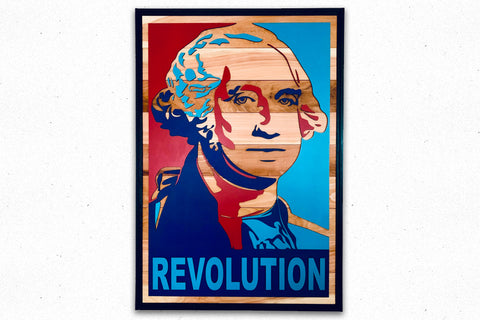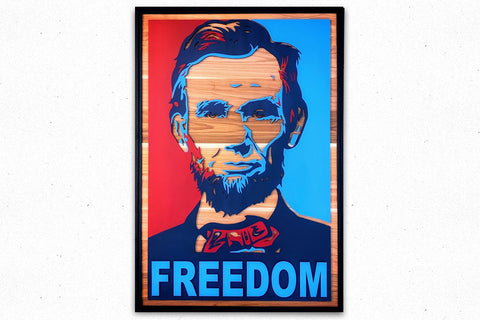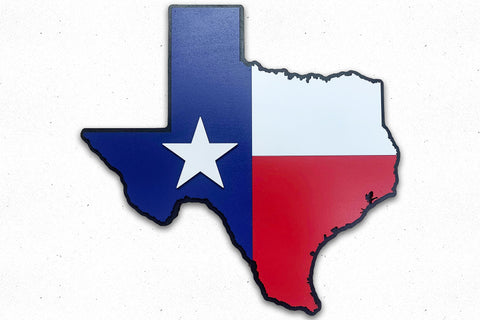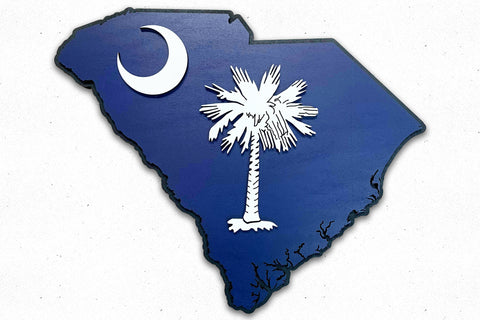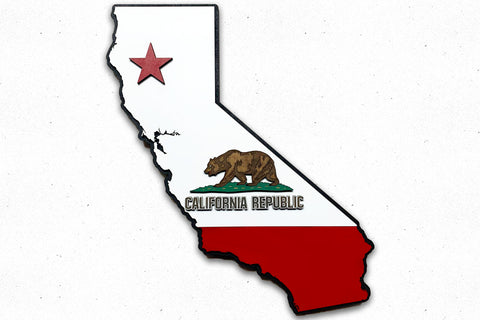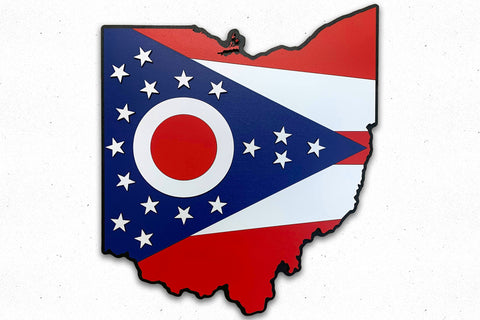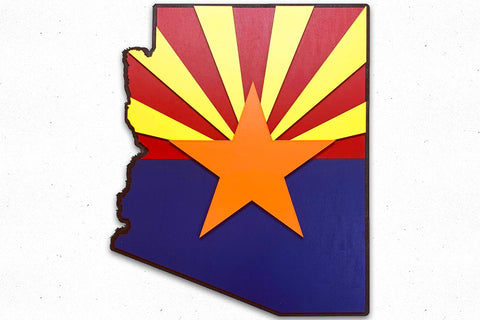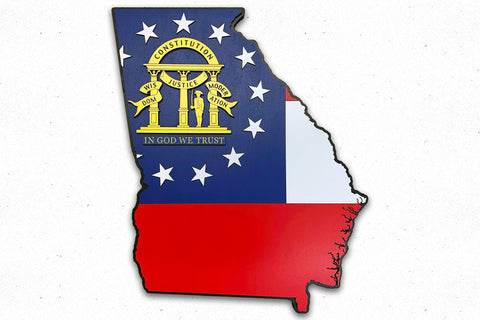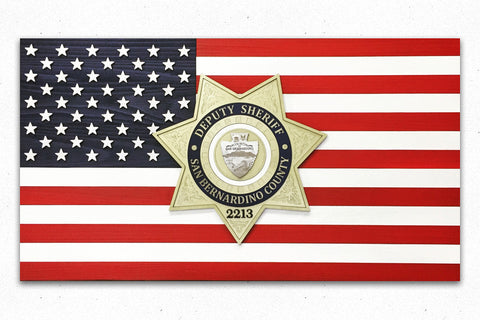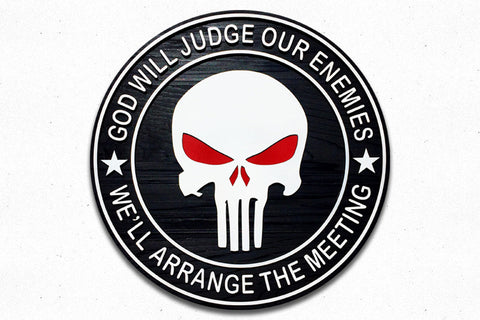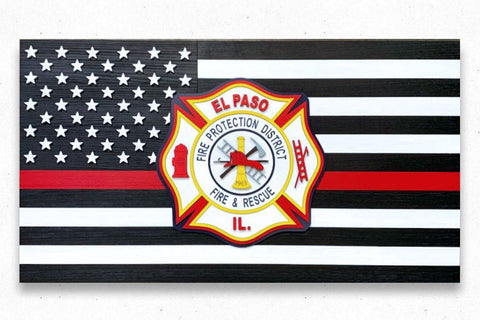Colorado became the 38th state 100 years after the United States’ birth, earning an apt nickname in the process: the Centennial State.
But while Colorado joined the Union in 1876, the Colorado flag we know today didn’t make an appearance until 1911, a full 35 years later. That flag, however, has represented Colorado ever since.
Over time, the Colorado flag became one of our nation’s most well-loved state flags. Its simple, recognizable design and distinct appearance have won it a place in many hearts. To understand more about the Colorado flag and why it’s one of our nation’s favorites, we investigated the history of the state it represents, its meaning and symbolism, and the life it’s had since its creation.
See more photos of our vintage Colorado wood flag >>
Colorado history: before the state flag
Before we get to the state flag, let’s take a look into Colorado’s statehood itself—after all, for a state flag to exist, there must be a state for it to represent.
Here’s how Colorado came to be, as well as the story behind each of the flags that flew over its land prior to the introduction of the current state flag.
Creating a state: Colorado’s path to the Union
The United States acquired Colorado’s land over time. Parts of it were included in both the Louisiana Purchase and the 1848 Treaty of Guadalupe, with the remainder coming in 1850, when the US government purchased Texas’ claims to the remaining land.
Like many other states, it wasn’t long before Colorado’s mineral-rich land began attracting miners and settlers. The discovery of gold drew prospectors to towns like Denver City, Auraria, and Montana City—strategically placed camps that provided access to the best mining locations.
This surge in gold-seekers spurred the famous “Pikes Peak or Bust” slogan. In 1859, large gold-lode strikes were made, attracting even more prospectors and growing the settlements’ population in a short period of time.
At this point, the settlers decided it was time to take control. They established the Jefferson Territory without government sanction for the sole purpose of governing the gold camps, electing officers and establishing structure. By 1860, they even operated Miners’ and People’s Courts.
This all changed in 1861, when the Territory of Colorado was organized under President James Buchanan. William Gilpin was appointed the first governor, and a few months later, a Supreme Court selected delegates. At this point, the territory’s population had surpassed 25,000 inhabitants and continued to grow, now as an official territory.
Calls for statehood began after the Civil War, but for more than 10 years, progress stalled: first when vetoed by President Andrew Johnson, then again when Congress did not act after President Ulysses S. Grant advocated for statehood.
It wasn’t until 1875 that Colorado’s time arrived. The territory’s population had grown to more than 100,000, and railroads ran to major cities. Statehood was the natural next step.
A 39-member Constitutional Convention convened on December 20, 1875, and began writing a new new state constitution modeled after the US government’s. It was written in 87 days, and today’s version very closely resembles the original.
On August 1, 1876, President Grant declared Colorado the 38th state, completing the territory’s route to statehood.
Colorado state’s boundaries are the same as those of the original territory. Unlike the majority of other states, geographical features weren’t used to create boundary lines. Instead, the federal government carved out a rectangle—making it one of only two states (the other being Wyoming) to have such a rectangular shape.
How did Colorado get its name?
Colorado gets its name from the Colorado River, the largest river in the region. Early Spanish explorers gave this river the name “Colorado”—Spanish for “colored red”—after they saw how the rock formations near the river and the mountain silt made the water look red.
When Colorado became a territory, people believed that this colorful river originated within its bounds, making “Colorado” the perfect name.
But as it turns out, the Colorado River’s actual headwaters were found near Moab, Utah. The section that continued into Colorado had another name: the Grand River. For years, the state was named after a river that didn’t even originate within its boundaries.
This changed in 1921, when Colorado congressman Edward T. Taylor brought forth a bill that would change the name of the Grand to Colorado, and thus extend the Colorado River into its namesake state.
Despite some opposition, Taylor’s efforts were successful, and the Grand River was renamed the Colorado. (Source)
The Colorado River didn’t just lead to a state name. Later on, we’ll see how it became a source of inspiration and symbolism for the Colorado flag.
What flew before the Colorado flag?
Before the Colorado flag’s adoption in 1911, more than 10 flags flew over the land. These flags included:
- Spain: In the 1500s, expeditions in the Southwest gave Spain claims to US regions, including Colorado’s land.
- France: In 1662, LaSalle floated down the Mississippi River, claiming the drainage area of the “Father of the Waters,” which included a large portion of Colorado’s land.
- Great Britain: In the 17th and 18th centuries, British Colonies extended their reach to the Pacific Coast, covering land claimed by the French and Spanish.
- Mixed territories: From 1763 to 1848, portions of Colorado belonged to France, Spain, Mexico, and the Republic of Texas.
- United States: In 1803, a part of Colorado came under US ownership with the Louisiana Purchase.
- US Territories: From 1803 to 1861, flags from a range of US territories were flown over Colorado.
(Source)
But beyond all of these flags, Colorado also had a state banner before the current flag came to be. For nearly five years, this simple Colorado flag served as a precursor to today’s design.
The 1907 State banner: a precursor to the current Colorado state flag
Yes, there was an official state flag before the current Colorado flag, but there wasn’t much to it.
Adopted In 1907, this simple flag was nothing more than the Colorado state seal on a blue background. Here’s the official act creating this flag, found in Colorado’s archives:
“AN ACT TO CREATE A STATE BANNER FOR THE STATE OF COLORADO.
Be it Enacted by the General Assembly of the State of Colorado:
That a state banner be and the same is hereby adopted to be used on all occasions when the state is officially and publicly represented. Said banner shall consist of the state coat of arms upon a dark blue ground. Penalties for misuse of the national flag now in force in this state shall be applicable to the said state banner.
Approved April 9th 1907.”
(Source)
This is what the 1907 Colorado flag looked like:
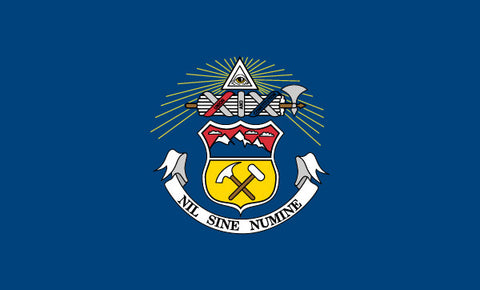
While certainly less visually appealing than the current design, this flag represented Colorado for four years.
For the curious, here’s the portion of the 1911 act that repealed the 1907 state flag:
“That an act entitled ‘An Act to Create a State Banner for the State of Colorado,’ approved April 9, 1907, and all other acts or parts of acts in conflict herewith are hereby repealed.”
(Source)
A straightforward end for a straightforward flag!
The current Colorado state flag
Colorado’s current flag was designed by Andrew Carlisle Johnson. There’s not much information on Johnson, beyond that it was his original design that became official in 1911.
What we do know, however, is that Johnson’s legacy lives on in this flag. His design captures the spirit of Colorado, perhaps in part because of the symbolism he imbued it with.
See more photos of our Colorado wood flag >>
Colorado flag colors
The colors of the Colorado flag are at the forefront of its symbolism. They capture the essence of various geographical features native to Colorado—features that make it stand out from other states, features that drew the first settlers to the area. Features that make Colorado, Colorado.
Red: for the color of Colorado’s soil
Besides inspiring early Spanish explorers to name the river they found the “Rio Colorado,” the red soil found in much of Colorado is symbolized in the state’s flag.
Blue: for Colorado’s clear sky
Blue symbolizes sky in many flags, including Colorado’s. The vibrant sky on a clear day is something of beauty.
White: for Colorado’s majestic, snow-capped mountains
Colorado’s mountains inspired then and continue to inspire today. Home to more than 50 fourteeners (mountains over 14,000 feet in elevation), Colorado has been known for its peaks for years. The sheer size, number, and beauty of these mountains makes their symbolic inclusion in the flag a must.
Coloradans have been skiing since the late 1880s, and winter sports enthusiasts from around the world continue to visit Colorado for the high terrain and powder snow. It’s no wonder that white was chosen for the flag!
Gold: for Colorado’s abundant sunshine
Colorado is known for its abundant sunshine. While debatable, it’s long been held that Coloradans experience more than 300 sunny days each year—that’s more sunny days than both Miami Beach and San Diego.
(Source)
Other symbolism in the Colorado flag
Besides the symbolism found in its four colors, the Colorado flag has two other pieces of symbolism. First, the “C”—an on-the-nose nod to the state name.
Second is something a bit more obscure. The state statute specifies that a cord of intertwined gold and silver tassels should accompany the flag. This could very well reference the gold and silver that drew the original settlers to Colorado in search of fortune.
Design recognition
Colorado’s flag is loved by many—we know that. But how does its design stack up when compared to other flags?
Pretty good, as it turns out. Colorado’s flag placed 16th out of 72 flags in the Great NAVA Survey of 2001. (NAVA, or the North American Vexillological Association, is a membership organization for Americans and Canadians interested in the scholarly study of flags.)
Besides 16th best overall, Colorado was rated the 11th-best state flag in this survey, which included flags from both the US and Canada.
Updates and changes to Colorado’s flag
The Colorado flag has remained largely unchanged since it was first adopted in 1911.
But since the original act established the flag, two additional statutes regarding the flag have passed. Neither of these have changed the core essence of the Colorado flag, rather, they’ve laid out specifications for different design elements to make the flag more consistent.
Why? For a long time, there were no official specifications for many of the flag’s design elements, which led to different design variants. The two statutes addressed this issue by providing more clear instructions for what the Colorado flag should look like.
Statute 1, in 1929: Color specifications for the Colorado flag
On February 28, 1929, the General Assembly stipulated the precise colors of red and blue to be the same as those from the national flag. Here’s an excerpt from the revision:
“. . . the two outer stripes to be blue of the same color as in the blue field of the national flag and the middle stripe to be white.”
(Source)
Statute 2, in 1964: Further instructions for the “C”
Controversy again arose over the size of the letter C, and on March 31, 1964, the General Assembly further modified the 1911 legislation by revising the distance from the staff for the letter C, as well as its diameter. Here’s the relevant excerpt:
“At a distance from the staff end of the flag of one thirty sixth FIFTH of the total length of the flag there shall be a circular red C, of the same color as the red in the national flag of the United States. The diameter of the letter SHALL BE one sixth TWO-THIRDS of the width of the flag.”
(Source)
Besides these two statues, there hasn’t been much controversy or change with Colorado’s flag since its creation.
It’s pretty amazing that a design from more than 100 years ago is so popular today, used on everything from T-shirts to mugs to wall art.
Current specifications for Colorado’s flag
With adjustments from the above statutes in mind, here are the current specifications for Colorado’s flag:
- The stripes: Three alternate stripes of equal width, the two outer stripes the same blue as the national flag, and the inner strip white
- The overall proportion of the flag: Its width should be 2/3 its length
- Placement of the circular “C”: From the staff end, place it one-fifth of the total length of the flag from the edge
- Size of the “C”: Diameter should be 2/3 the width of the flag, with the inner line of the opening 2/3 the width of its body and the outer line double the length of the inner line
- Color of the “C”: The same red as the national flag
More information about the specifications can be found here.
Bring the Colorado flag into your home with custom wall art from Patriot Wood
We make high-quality wooden flags that are built to last, and our Vintage Colorado Wood Flag is one of our favorites. Here are some photos of this flag:
Check out our Vintage Colorado Wood Flag, and add a bit of Colorado history to your home today!






